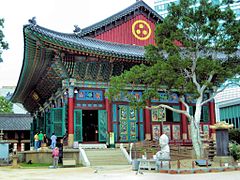Daily meditation:
Feeling the divine love at Jogyesa Temple and connecting the dots of destiny as in the art of Whanki…

It’s the first time when I was at a Buddhist temple visiting Jogyesa Temple, but also when I felt the connection of divine love so sharp and clear in a temple or church for that matter.
Could be a connection again with the past lives in reality?!
Too many weird things happened since I arrived in Seoul.
For example, lately, I felt the connection of love inside so intense with Her as it never happened before.
Like a fishing net, it keeps my mind and heart so close to her existence that I can’t breathe anymore.

Although nothing else besides inside my existence happened, Her is still feeling like a reality boggling my mind and ravaging my heart.
It makes me wonder why and how it happened only to my Self?!
Is it a connection in reality with Her or just a damn mind hallucination?!
Or maybe it’s so abstract that can’t figure it out the meaning so quickly as in dot paintings of Whanki Kim?!
I wonder if her soul image exists or again, my visions are not from this time. Maybe a different one?!
With all these troubling questions without answers, I can’t contest the feelings of her existence inside so profound no matter I tried or did.
Same it happens with events and connection of her soul image presence in Seoul.
Why December and what events related to Her made me search and connect with my visions related to Korea?!
Even if I know the importance of spreading the message of divine love in the future, it’s so hard sometimes.
Despite everything not happening outside of my soul image, inside my heart, feelings got unfolded, and events and signs related to Her had great importance for my soul all the time in Seoul, and especially these days.
It seems as small things, walking side by side with Han River visions of Her, feelings of love beamed up from Namsan Tower, her steps on Sewoon Rooftop.
Her soul image presence in my dreams, also in reality as a hologram following my mind and heart anywhere around Seoul, it couldn’t happen in another place than here at this pace and so intense.
And soon I will go back to my happy sorrow feelings missing Her from afar as the distance already proved to be essential for my soul connection with her existence.
Well, maybe it’s for the best.
Better to miss Her being far away than close to and with her soul image nowhere to be found… Or not connected with my soul image in this reality.
Maybe after all, impossible, it is possible to exist only for my soul image and not for my heart and soul.
Information notes:
Kim Whanki, also Kim Whan-ki or Kim Hwan-gi (1913–1974, hangul: 김환기), was a pioneering abstract artist of Korea. Born February 27, 1913, in the village of Eupdong-ri on the island of Anjwado, Sinan County, South Jeolla Province, Kim died in New York City, USA, on July 25, 1974.
Kim belongs to the first generation of Korean abstract artists, mixing oriental concepts and ideals with abstraction. With refined and moderated formative expression based on Korean Lyricism, he created his characteristic art world. His artworks largely dealt with diverse hues and patterns. Kim’s early works were semi-abstract paintings which allowed beholders to see certain forms, but his later works were more deeply absorbed abstract paintings, filled with lines and spaces.
Respected domestically and abroad, the Whanki Museum, dedicated to Kim, opened in Seoul in 1992.More info about “Kim Whanki“:
https://en.m.wikipedia.org/wiki/Whanki_Kim
The Whanki Museum is a private art museum in Jongno-gu, in central Seoul, South Korea. It was established by the Whanki Foundation mainly to exhibit and commemorate the art of Whanki Kim, one of Korea’s foremost abstract painters. The museum is located in Buam-dong, close to Seongbuk-dong, Seongbuk-gu, where Whanki Kim and his wife spent many years. The atmosphere and natural environment of the two places have much in common. The museum building was designed by architect Kyu-seung Woo. Construction began in 1990, and the museum opened in November, 1992.
More info about “Whanki Museum“:
https://en.m.wikipedia.org/wiki/Whanki_Museum
Jogyesa (Jogye Temple) is the chief temple of the Jogye Order of Korean Buddhism. The building dates back to the late 14th century and became the order’s chief temple in 1936. It thus plays a leading role in the current state of Seon Buddhism in South Korea. The temple was first established in 1395, at the dawn of the Joseon Dynasty; the modern temple was founded in 1910 and initially called “Gakhwangsa”. The name was changed to “Taegosa” during the period of Japanese rule, and then to the present name in 1954.
Jogyesa is located in Gyeonji-dong, Jongno-gu, in downtown Seoul. Natural monument No. 9, an ancient white pine tree, is located within the temple grounds. Jogyesa Temple is located in one of the most popular cultural streets in Seoul, Insa-dong, near the Gyeongbokgung Palace.More info about “Jogyesa Temple“:
https://en.m.wikipedia.org/wiki/Jogyesa






